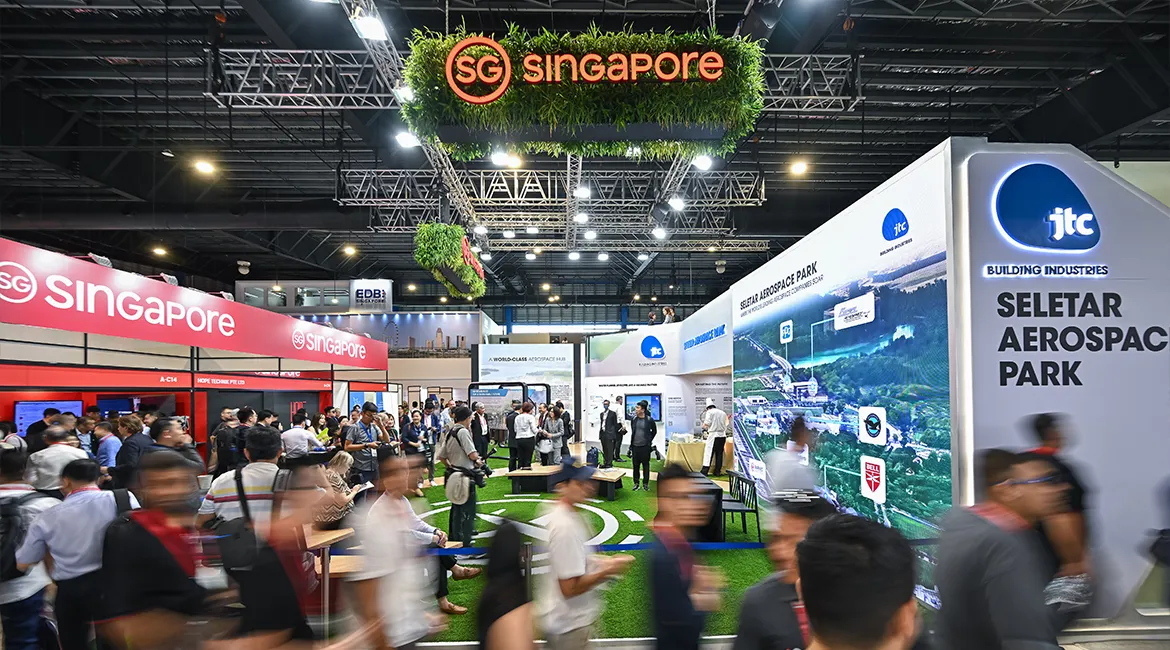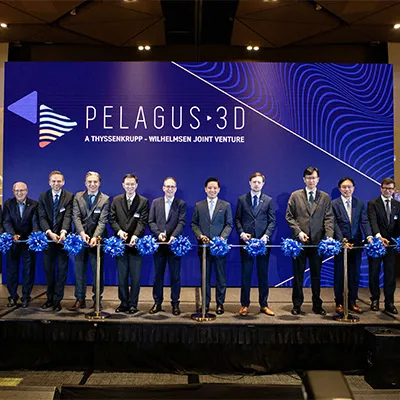Over 1,000 companies from more than 50 countries and regions, and nearly 60,000 trade show attendees took part in the Singapore Airshow 2024 from February 20-25. Asia’s largest aerospace event also received 60,000 public visitors.
The outlook for aerospace is bright. International passenger traffic is projected to double by 2040, and the global maintenance, repair and operations (MRO) market is expected to grow more than 33 per cent between 2023 and 2033.
Asia-Pacific is expected to be a strong driver of growth – Singapore’s aerospace output and workforce have expanded in the last two years.
Since the last Singapore Airshow in 2022, companies have committed to investing over S$750 million across over 10 projects, over the next three to five years. The industry is also set to hire over 2,500 job roles in the same time period to support business expansion plans including these investments.
Many of these projects were announced on the sidelines of the Singapore Airshow. The projects span various areas, from manufacturing, MRO, innovation and sustainability. Here’s a recap of the announcements that will shape the continued growth of Singapore’s aerospace industry.
1. Embraer, CAE launch E-Jets E2 first full flight simulator in Asia-Pacific
Brazilian aircraft manufacturer Embraer and global leader in training and simulation CAE inaugurated Asia Pacific’s (APAC) first E-Jets E2 full-flight simulator (FFS) at the Airshow. A cutting-edge facility that offers immersive training for pilots preparing to operate Embraer’s E190-E2 aircraft, this simulator is already being used by pilots from Scoot, a subsidiary of Singapore Airlines, in their rigorous training ahead of Embraer’s new aircraft’s anticipated entry into service later this year.
Housing the full-flight simulator in Singapore strategically situates Embraer at the heart of this vibrant region to support the growing demand of E-Jets E2 aircraft and enhance the skills of aerospace and aviation talent.
Read more here.
2. Eagle Services Asia launches expanded facility in Singapore
Global aerospace manufacturer Pratt & Whitney, together with its joint-venture partner, SIA Engineering Company (SIAEC), opened their expanded Singapore-based engine centre, Eagle Services Asia (ESA).
This latest expansion will grow ESA’s capacity for Geared Turbofan (GTF) engine MRO by 60 per cent this year. The new site integrates robotics and automation solutions that are developed in Singapore by Pratt & Whitney’s Singapore Technology Accelerator, to boost productivity and efficiency.
Pratt & Whitney, the company behind the geared turbofan engine used in commercial aircrafts such as the Airbus A320neo, began its operations in Singapore more than 40 years ago with a repair and overhaul facility for small engines at Seletar Airport. Since then, the company has grown to more than 2,500 employees here, across a range of activities including MRO, manufacturing and R&D.
Read more about ESA here.
3. Singapore Aero Engine Services to almost double MRO presence in Singapore
Singapore Aero Engine Services Private Limited (SAESL), a joint venture between Rolls-Royce and SIAEC, announced a US$180 million (S$242 million) expansion in Singapore. This expansion will increase their engine MRO capacity by 40 per cent, and create 500 new engineering jobs over the next 5 years.
One of the world’s largest Rolls-Royce Trent engine MRO organisations, SAESL’s expansion will drive transformation through technology by developing new MRO processes, core digital technology and Industry 4.0 capabilities.
SAESL also inked MOUs with several agencies and partners:
- With EDB and JTC, to enter into discussions to facilitate the expansion of its MRO facilities and explore potential support in expanding SAESL’s footprint in Singapore, and
- With the Employment and Employability Institute (e2i), NTUC Learning Hub (NTUC LHUB) and the Institute of Technical Education (ITE), to promote and generate awareness of the 500 new engineering career opportunities. NTUC LHUB will be appointed as the preferred training partner of SAESL.
Find out more about SAESL’s plans in Singapore here.
4. Safran Electrical & Power to open new facility
Safran Electrical & Power is set to open a new 2,800 sq m facility in Seletar Aerospace Park for manufacturing as well as MRO for aeronautical electrical equipment.
Safran has been in Singapore for over 45 years. Its activities span commercial aviation and helicopter propulsion, aircraft equipment and interiors as well as defence. It has close to 800 employees across seven entities and five sites covering production, engineering, customer support and MRO.
Learn more here.
5. Airbus champions Sustainable Aviation Hub in Singapore
Singapore is home to Airbus’ Asia-Pacific HQ. Airbus and EDB have signed an MOU to facilitate the establishment of a Sustainable Aviation Hub focused on technology, research, and innovation. This hub will champion sustainable aviation practices and foster collaboration with local enterprises, universities and research institutions, emphasising areas such as Decarbonising Aviation, Maintenance, Services, Operations, as well as Air Traffic Management and Unmanned Air Traffic Management.
Learn more here.
6. Supernal to focus on advanced air mobility from Singapore
Supernal LLC, Hyundai Motor Group’s Advanced Air Mobility (AAM) company, has partnered with EDB and the Civil Aviation Authority of Singapore (CAAS) to explore opportunities in AAM development for the region – driving research, standards development, and public engagement initiatives for AAM across the Asia Pacific region.
Read more here.
7. Thales to set up Avionics Centre of Excellence
Thales in Singapore currently hosts Thales’ leading sites for avionics manufacturing and MRO services. The French technology group, which celebrated its 50th year in Singapore last year, has announced plans to set up an Avionics Centre of Excellence (CoE) at its Avionics Asia-Pacific Industrial Centre in Changi North Rise, Singapore. The CoE will support the future industrialisation of new flight avionics products from Singapore, as well as undertake new Smart Factory transformation initiatives.
Learn more here.
8. GE Aerospace invests S$15 million in Smart Factory for engine component MRO
GE Aerospace is investing US$11 million (S$14.8 million) to transform its Singapore aircraft engine repair facility at Seletar Aerospace Park into a state-of-the-art “Smart Factory”.
This site will host automated inspection systems, innovative material removal processes, and digitalisation technologies to meet surging demand for the American engine supplier’s high-quality components.
Singapore already hosts GE Aerospace’s largest engine MRO facility, accounting for more than 60 per cent of its global repair volumes and employing more than 2,000 people across three sites in Seletar and Loyang.
Learn more here.
9. Barnes Aerospace expands Singapore facility
Barnes Aerospace has expanded its engine component repair footprint in Singapore’s Seletar Aerospace Park by 50 per cent to serve growing demand from customers across Asia.
With support from EDB, local employees from Barnes Aerospace will be equipped with the relevant knowledge and certifications to perform manufacturing and MRO functions.
Barnes Aerospace’s expansion reinforces Singapore’s position as a leading MRO hub in the region, and a global node for aerospace manufacturing and MRO.
Learn more here.
10. Pratt & Whitney expands manufacturing & enhances MRO capabilities in Singapore
Pratt & Whitney will invest US$20 million (S$27 million) to expand its manufacturing capacity in Singapore located at Seletar Aerospace Park, producing more crucial components for its GTF engine family.
Additionally, Pratt & Whitney Canada, which has a presence in Singapore, announced plans to enhance its MRO capabilities here. It will add a new MRO line for the PT6C-67C engine that powers the Leonardo AQ139 helicopters, complementing the existing overhaul capability of the Saint Hubert Engine Center in Canada to serve global customers.
Read more here.
What else you need to know
- JTC and EnterpriseSG jointly unveiled the Aerospace Open Innovation Challenge 2024, supported by EDB and the Association of Aerospace Industries – Singapore (AAIS). This Challenge aims to foster collaboration in innovation between industry players and promising startups and SMEs within the aerospace industry. Read more here.
- Singapore also unveiled its Sustainable Air Hub blueprint. Developed by the Civil Aviation Authority of Singapore (CAAS) and other stakeholders, the blueprint sets out Singapore’s action plan for the decarbonisation of its aviation sector, through efforts in the airport, airline and air traffic management domains. Notably, the blueprint outlines plans to build up the ecosystem to support the use of Sustainable Aviation Fuel (SAF) in Singapore. This includes requiring flights departing Singapore to use SAF from 2026. The aim is for a one per cent SAF target from 2026, and for this to reach three to five per cent by 2030. CAAS estimates that the use of sustainable jet fuel will reduce Singapore’s international aviation emissions by about 4 per cent from 2030 business-as-usual levels, contributing towards Singapore’s 2050 net-zero goal. Read more here.
- The Singapore International Mediation Centre and Hague Court of Arbitration for Aviation also signed an MOU to promote the adoption and facilitation of mediation in aviation-related disputes in Asia through developing a specialised mediation framework. As one of Asia’s largest and most diverse aviation ecosystems, such dispute resolution mechanisms are crucial and builds on Singapore’s position as an international legal services and dispute resolution hub. Read more here.
Aerospace companies in Singapore have plans to hire over 2,500 employees in the next 3 to 5 years to support their growth. Mid-career professionals can tap on initiatives like the Workforce Singapore's Career Conversion Programme to transition into roles in aviation.
Read more to find out about career growth prospects in this growth industry here.






